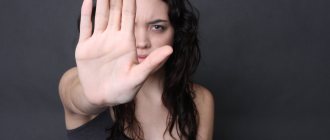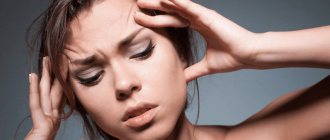Nocturnal panic attacks, sometimes called “nighttime panic attacks,” can occur either during sleep or while trying to fall asleep. They are characterized by a sudden onset of fear, and usually lead to a variety of unpleasant physical symptoms. These may include:
- Cold sweat
- Cardiopalmus
- Hyperventilation and shortness of breath
- Fluctuations in body temperature (fever or chills)
- Chest pain
- A depressing feeling of doom
Panic attacks usually don't last more than 10 minutes, but the effects (which can be emotional, physical, and cognitive) can last a long time.
Why do panic attacks happen at night?
At night, we are left alone with our fears. It is easier to escape from worries and unpleasant thoughts during the day than at night. If a person is prone to anxiety and has a number of accumulated problems, or is experiencing stress, then the likelihood of nighttime panic attacks increases.
In this state, our brain is in “defense mode,” constantly monitoring for threats, including any changes it senses in the body. So if you go to bed feeling tense, when your body begins to relax, it may perceive it as something dangerous and trigger a stress response. Panic attacks are your body's way of protecting you.
Sleep disturbances in anxiety and anxiety-depressive disorders
Combination of sleep disorders and anxiety disorders
It is known that the relationship between sleep disorders and anxiety disorders is observed, on the one hand, when sleep disorders can provoke the development of anxiety disorders [5], and on the other, when the onset of an anxiety disorder precedes the onset of sleep disorders.
Complaints about problems related to sleep are typical for patients with all diseases included in the group of anxiety disorders. In the case of major generalized disorder and post-traumatic stress disorder (PTSD), sleep disturbances are one of the criteria necessary for diagnosis. There are objective reasons for the development of sleep disorders within the framework of anxiety disorders, namely: anxiety is manifested by increased cortical activation, which entails difficulty falling asleep and maintaining sleep. In the clinic, anxiety manifests itself as restlessness, irritability, motor agitation, decreased concentration, and increased fatigue [6].
The most striking manifestation of anxiety disorders is generalized anxiety disorder (GAD), which is diagnosed based on the presence of at least 3 of the following symptoms: restlessness, fatigue, difficulty concentrating, irritability, muscle tension, and sleep disturbances. The duration of the disease must be at least 6 months, the symptoms must cause psychosomatic discomfort and/or social maladjustment.
Sleep disturbances in this situation are one of the 6 diagnostic criteria for GAD. The main symptom of GAD is excessive, persistent anxiety, which is the main factor predisposing to the development of insomnia. Insomnia and GAD are closely related, usually comorbid, disorders. The difference between insomnia due to an anxiety disorder and primary insomnia not associated with other diseases is the nature of the experience during the process of falling asleep. In the case of GAD, the patient is worried about current problems [7] (work, study, relationships), which interferes with the process of falling asleep. In the case of primary insomnia, it is the disease itself that causes concern.
A polysomnographic study can reveal changes characteristic of insomnia: increased time to fall asleep, frequent awakenings, decreased sleep efficiency, and a decrease in its total duration.
Another striking example of anxiety disorders is panic disorder, which is manifested by recurrent states of severe anxiety (panic). The attacks are accompanied by phenomena of depersonalization and derealization, as well as severe autonomic disorders. The patient's behavior shows avoidance of situations in which the attack first occurred. Fear of loneliness and a recurrence of the attack are possible. A panic attack occurs spontaneously, outside of formal situations of danger or threat.
Panic disorder is more common in women and usually begins around age 20. A distinctive feature of panic disorder is spontaneous episodes of panic attacks, characterized by attacks of fear, anxiety and other vegetative manifestations. About 2/3 of patients suffering from this disorder experience some kind of sleep disturbance. Patients complain of difficulty falling asleep, non-restorative sleep, as well as characteristic nocturnal panic attacks. It should be noted that the presence of certain sleep-related problems can lead to worsening anxiety disorders, including panic disorder.
Polysomnographic testing can detect frequent awakenings, decreased sleep efficiency, and a reduction in total sleep duration [8]. It is not uncommon to observe a combination of depression and anxiety disorders, and therefore there is a possibility that the presence of other changes in sleep structure in patients with panic disorder is associated with comorbid depression, therefore it is necessary to exclude the diagnosis of depression in patients with similar sleep disorders.
Sleep paralysis, a characteristic of narcolepsy, can also occur with panic disorder. It is a motor paralysis that occurs when falling asleep or waking up, during which patients experience fear, a feeling of tightness in the chest and other somatic manifestations of anxiety. This symptom also occurs in patients with post-traumatic stress disorder.
Nocturnal panic attacks are a common occurrence in this disease [9]. They manifest themselves with a sudden awakening and all the symptoms characteristic of panic attacks. Awakening occurs during the slow-wave sleep phase, which most likely excludes their connection with dreams. It was also found that night attacks are an indicator of a more severe course of the disease. It must be remembered that patients, fearing a repetition of such episodes, deprive themselves of sleep, which leads to more serious disorders and generally reduces the quality of life of these patients.
PTSD is a disease from the group of anxiety disorders in which sleep disturbances are a diagnostic criterion. Sleep disturbances in this disease include 2 main symptoms: nightmares and insomnia. Other phenomena inherent in PTSD and associated with sleep are: somnambulism, sleep talking, hypnagogic and hypnopompic hallucinations. The changes detected by polysomnography are not specific and in some cases may be absent. Possible changes include: an increase in the representation of the 1st stage of sleep, a decrease in the representation of the 4th stage of sleep. Also, with PTSD, breathing disorders during sleep are often found.
Agoraphobia, which is defined as anxiety that arises in response to situations from which, in the patient’s opinion, is difficult to escape, can also be a manifestation of anxiety disorders. In the clinical picture, as a rule, there is a persistent fear of the patient being in crowded places, public places (shops, open squares and streets, theaters, cinemas, concert halls, workplaces), fear of independent long trips (on various types of transport). The situational component of agoraphobia syndrome is expressed in the confinement of phobic experiences to certain situations and in the fear of getting into situations in which, according to patients, a repetition of painful sensations is likely. Often agoraphobic symptoms cover many fears of various situations, forming panagoraphobia - fear of leaving the house with the development of deep social maladaptation. The patient's attempts to overcome his own experiences are observed; in unfavorable cases, social activities are limited.
Specific phobias are characterized by the connection of anxiety with certain situations (air travel, contact with animals, the sight of blood, etc.), also accompanied by an avoidance reaction. Patients are critical of their experiences, however, phobias have a significant impact on various areas of the patients’ activities. The following forms are found: cardiophobia, cancerophobia, claustrophobia, etc. Sleep disturbances in these patients are nonspecific, and from the patient’s point of view they are a minor manifestation of the disease.
In general, the most common manifestations of sleep disorders in anxiety states are presomnia disorders. The initial phase of sleep consists of 2 components: drowsiness, a kind of desire to sleep, and falling asleep itself. Often, patients have no desire to sleep, no desire to sleep, muscle relaxation does not occur, and they have to perform various actions aimed at falling asleep. In other cases, the desire to sleep is present, but its intensity is reduced, and drowsiness takes on an intermittent, wave-like character. Drowsiness occurs, muscles relax, perception of the environment decreases, the patient takes a comfortable position for falling asleep, and a slight drowsy state appears, but soon it is interrupted, disturbing thoughts and ideas arise in the mind. Subsequently, the state of wakefulness is again replaced by slight drowsiness and superficial drowsiness. Such changes in states can be repeated several times, leading to emotional discomfort that prevents the onset of sleep.
In a number of patients, worries about disturbed sleep can acquire an overvalued-hypochondriacal coloring and, according to the mechanisms of actualization, come to the fore; often an obsessive fear of insomnia arises - agripnophobia. It is usually combined with an anxious and painful expectation of sleep, certain demands on others and the creation of the special conditions noted above for sleep.
Anxious depression is characterized by the patient's constant experience of anxiety, a sense of impending threat and uncertainty. Anxious experiences change: worry about your loved ones, fears about your condition, your actions. The structure of anxious depression, as a rule, includes anxious fears, feelings of guilt, motor restlessness, fussiness, fluctuations in affect with worsening in the evening hours, and somatovegetative symptoms. Anxious and melancholy affects often occur simultaneously; in many cases it is impossible to determine which of them is leading in the patient. Anxious depression most often occurs in people of involutionary age and occurs in protracted phases. In addition, it is actually the leading type of depression of the neurotic level [10].
The patient exhibits a variety of symptoms of anxiety and depression. Initially, one or more somatic symptoms may be detected (for example, fatigue, pain, sleep disturbances). Further questioning reveals depression and/or anxiety.
Signs of anxious depression:
- low mood;
- loss of interests;
- pronounced anxiety.
The following symptoms are also often detected:
- sleep disorders;
- physical weakness and loss of energy;
- fatigue or decreased activity;
- difficulty concentrating, fussiness;
- impaired concentration;
- agitation or inhibition of movements or speech;
- appetite disorders;
- dry mouth;
- tension and anxiety;
- irritability;
- tremor;
- heartbeat;
- dizziness;
- suicidal thoughts.
Often with anxious depression, variants of presomnia disorders are observed, in which the desire to sleep is pronounced, drowsiness increases quickly, and the patient falls asleep relatively easily, but after 5–10 minutes he suddenly wakes up, drowsiness completely disappears, and then for 1–2 hours he does not can fall asleep. This period without sleep is characterized by unpleasant ideas, thoughts, fears, reflecting, to a greater or lesser extent, the experienced conflict situation and the reaction to the inability to sleep. Hyperesthesia to sensory stimuli is also observed. Those suffering from this form of sleep disorder react extremely painfully to the slightest sensory stimuli, even outbursts of passion.
Disturbed sleep patterns are characterized by a prolongation of the drowsy period. This drowsy state is often accompanied by motor, sensory and visceral automatisms, sharp shudders, vivid perceptions of sounds and visual images, palpitations, and sensations of muscle spasms. Often these phenomena, awakening the patient, cause various painful ideas and fears, sometimes acquiring an obsessive character.
Sleep disorders and their polysomnographic manifestations among mental illnesses have been most studied for depressive disorder. Among the sleep disorders associated with depressive disorder, the most common is insomnia. The severity and duration of insomnia are manifestations of a more severe depressive disorder, and the appearance of insomnia during remission indicates the imminent occurrence of a repeated depressive episode [1]. In addition, sleep disorders in this disease are the most persistent symptom. The close relationship of this disorder with sleep disorders is explained by the biochemical processes characteristic of depression. In particular, in depressive disorder there is a decrease in the level of serotonin, which plays a role in initiating REM sleep and organizing delta sleep [11]. Depressive disorder is characterized by the following manifestations of sleep disturbances: difficulty falling asleep [10], non-restorative sleep, and, as a rule, reduced total sleep time. The most specific symptoms for depression are frequent awakenings at night and early terminal awakening. Complaints of difficulty falling asleep are more often observed in young patients, and frequent awakenings are more common in older patients [12].
With masked depression, complaints of sleep disturbances may be the only manifestation of the disease. With depression, in contrast to primary insomnia, there are complaints of sleep disturbances that are typical for this disease: frequent awakenings, early morning awakening, etc. [12].
In a polysomnographic study, the following changes are observed: an increase in the time it takes to fall asleep, a decrease in sleep efficiency. The most common symptoms specific to depressive disorder are shortened REM sleep latency and decreased delta sleep. It has been found that patients with a higher proportion of delta sleep remain in remission longer compared to patients who experience a decrease in the proportion of delta sleep [13].
Attempts have been made to explore the possibility of using depression-specific sleep disturbances as markers of depressive disorder. Due to the heterogeneity of the manifestations of sleep disorders, this issue remains not fully resolved.
The characteristics of sleep disturbances in various types of depression were also highlighted. Patients with a predominance of the anxiety component are more likely to have difficulty falling asleep and early awakenings. With this type of depression, dream plots are associated with persecution, threats, etc. In addition, these patients generally had a high level of wakefulness before falling asleep. For depression with a leading affect of melancholy, early morning awakenings and dreams of static types of gloomy content are most characteristic. Depression with apathy affect is characterized by early awakenings and rare, unsaturated dreams. Also typical for depression with apathetic affect is the loss of the sense of boundaries between sleep and wakefulness. Patients with bipolar disorder have a similar polysomnographic picture [14].
Features of sleep disturbance in bipolar disorder are a significant decrease in sleep duration during a manic episode and a greater tendency of patients to hypersomnia during depressive episodes compared to the unipolar course of the disorder. There are usually no complaints of sleep disturbances during manic episodes.
Treatment
For the treatment of anxiety and depressive disorders, drugs of various pharmacological groups are used: tranquilizers (mainly long-acting or short-acting benzodiazepine drugs), selective serotonin reuptake inhibitors, selective serotonin reuptake stimulants, tricyclic antidepressants. All of these drugs, to one degree or another, affect a person’s sleep, making it easier to fall asleep, reducing the number and duration of night awakenings, thereby affecting the recovery processes that occur during night sleep. When developing tactics for treating sleep disorders combined with anxiety and depressive symptoms, it is important to remember that insomnia itself can increase anxiety, worsen well-being, and mood, usually in the morning after poor sleep [15]. In this regard, the use of hypnotics in treatment may be promising if insomnia symptoms are predominant in the clinical picture in order to prevent exacerbation of anxiety and depressive disorders. In this regard, the most effective assistants can be hypnotics that affect the GABAergic (GABA - γ-aminobutyric acid) system - histamine receptor blockers (Valocordin®-Doxylamine) and melatonin preparation. The most convenient to use in the treatment of insomnia is Valocordin®-Doxylamine, which is available in drops, which allows you to select an individual dose of the drug.
Valocordin®-Doxylamine is a unique drug used as a hypnotic. Most of the known hypnotic drugs (benzodiazepines, cyclopyrrolones, imidazopyridines, etc.) act on the GABAergic complex, activating the activity of somnogenic systems, while histamine receptor blockers act on the waking systems, not sleep, reducing their activation. A fundamentally different mechanism of hypnotic action allows Valocordin®-Doxylamine to be used more widely: when changing one drug to another, reducing the dosage of “habitual hypnotics,” as well as when it is necessary to discontinue hypnotics.
A study of the drug in healthy subjects showed that doxylamine succinate leads to a decrease in the duration of night awakenings and stage 1 sleep and an increase in stage 2 sleep without a significant effect on the duration of the 3rd and 4th stages of sleep and REM sleep. There was no significant subjective effect on the reports of healthy volunteers; however, compared with placebo, doxylamine increased the depth of sleep and improved its quality [16].
In Russia, one of the first studies was carried out under the leadership of A.M. Wayne [17]. It has been shown that under the influence of doxylamine, such subjective characteristics of sleep as the duration of falling asleep, the duration and quality of sleep, the number of night awakenings and the quality of morning awakening improve. Analysis of objective sleep characteristics showed that while taking doxylamine, there is a reduction in the time of wakefulness during sleep, a decrease in the duration of falling asleep, an increase in sleep duration, REM sleep phase time, and the sleep quality index. It was also shown that doxylamine did not reduce the effectiveness of the use of other drugs in patients, such as antihypertensive, vasoactive, etc. The results of a study of the effect of doxylamine on patients with insomnia indicate the effectiveness of this drug in these patients. Subjective feelings of a positive effect are confirmed by objective studies of the structure of sleep, which is undergoing positive changes, which affect indicators such as sleep duration, duration of falling asleep, REM sleep phase. Of great importance is also the absence of any changes in the results of questionnaire data regarding drowsiness and sleep apnea syndrome, which indicates the absence of an aftereffect of the drug in relation to the worsening of obstructive apnea syndrome. However, if obstructive sleep apnea is suspected, doxylamine should be prescribed with caution.
Modern clinical studies do not reveal serious side effects when treated with therapeutic doses of the drug, but it is always necessary to remember the possible appearance of symptoms that arise due to the individual characteristics of the body, and contraindications (glaucoma; difficulty urinating due to benign prostatic hyperplasia; age under 15 years; increased sensitivity to the drug).
Simultaneous use of the drug Valocordin®-Doxylamine and sedatives that affect the central nervous system (CNS): antipsychotics, tranquilizers, antidepressants, hypnotics, analgesics, anesthetics, antiepileptics, may enhance their effect. Procarbazines and antihistamines should be combined with caution to minimize CNS depression and possible drug potentiation. During treatment with Valocordin®-Doxylamine, alcohol should be avoided as it may unpredictably interfere with the effects of doxylamine succinate.
While using this drug, it is recommended to avoid driving a car and operating machinery, as well as other activities accompanied by an increased risk, at least in the first stage of treatment. It is recommended that the attending physician evaluate the individual reaction rate when choosing a dose. These features of the drug’s influence are important to consider when treating patients with insomnia in order to increase the effectiveness of the drug Valocordin®-Doxylamine and eliminate possible undesirable effects.
Conclusion
When diagnosing the disease, it is important to remember that, as a rule, problems falling asleep indicate the presence of severe anxiety, early awakenings are a manifestation of depression. When choosing treatment tactics at all stages of the development of anxiety-depressive syndrome (ADS), the prescription of modern sleeping pills at the stage of unexpressed ADS is a promising tactical approach aimed at reducing the risk of further increase in symptoms of anxiety and depression.
Nightmares
Panic attacks that occur during sleep are usually caused by nightmares. Nightmares are considered a form of sleep disorder that affects the nervous system, causing unusual behavior.
Nightmare
Nightmares are episodes of intense fear during sleep, usually occurring in the first third of the night. You may wake up terrified with a frantic intensity of physical symptoms that trigger a panic attack.
Causes
Biological reasons may be due to the fact that the endocrine glands begin to release large amounts of adrenaline into the blood. This hormone is normally produced in extreme situations that threaten human health or life. It is this that influences the acceleration of all physiological reactions, that is, the heartbeat quickens, the sweat glands and lungs begin to work harder. This is how the body prepares to defend or escape from a mortal threat.
But why does this hormone begin to be released during sleep, when a person is safe and not in danger? The answer to this question is not yet completely clear. Most likely, there are individual psychological reasons here - for example, increased personal anxiety as a character trait: most often, attacks occur in suspicious, emotionally vulnerable and anxious people. It is they who are most prone to self-flagellation and long experiences of life events; and/or negative experience of relationships in the past, in which a person acquired such qualities as distrust, suspicion, lack of internal, psychological permission to relax (“you can’t lose control for a minute, you can’t relax - otherwise something irreparable will happen”).
Provoking factors for panic attacks at night during sleep are:
- Chronic drinking or drinking too much alcohol before bed.
- Severe stress.
- Childhood psychological trauma.
- Hormonal disorders.
- Exhaustion of the nervous system due to constant worries and stress.
- Hereditary predisposition to anxiety disorders.
- Traumatic brain injuries.
- Work activity that involves constant emotional stress or risk to life.
According to statistics, about 50% of people diagnosed with neurosis or vegetative-vascular dystonia suffered from nighttime panic attacks.
What to do when attacks occur before bed?
As mentioned above, at night we often begin to process all the stresses of the day or worry about the day ahead. Panic attacks before bedtime usually occur during stressful moments in life, when our head is filled with problems. Maybe these are quarrels in relationships, conflicts at work, a period of painful changes.
After we've had a panic attack, worrying about it happening again can create a vicious cycle in which we become afraid to fall asleep. Although this type of reaction is considered normal, it often causes even more concern.
What to do if you have a panic attack at night
If you are having a panic attack, experts advise taking the following steps:
- Close your eyes and inhale slowly and deeply through your nose.
- Then exhale slowly and deeply through your mouth.
- If you can, continue this process as long as it lasts, counting 1 - 5 on each inhalation and exhalation.
Try to accept that you are experiencing a panic attack without any resistance. When we try to fight anxiety, we only make it worse. It can be scary, but try to move towards the anxiety rather than away from it.
Panic attack
Once you feel better, the worst is over. Just remember – your body is on high alert right now, so it will likely take some time to calm down again. So sleep is out of the question for a while.
Anxiety before bed: what you can do about it
Sleep and insomniaAnxietyExercise
Who doesn’t know this feeling: you’re lying in bed, but it’s impossible to sleep because there are a lot of problems spinning in your head? Do this and this and this and this. Don't forget something. Take this into account. What if something like this happens
Anxieties flow one upon another, and instead of pleasant drowsiness, a stupid feeling of heightened nervous excitement arises. What a dream this is.
Subsequently, it is possible that meta-anxiety, or anxiety about anxiety, may arise: “Yesterday I couldn’t sleep well, what if I have trouble falling asleep again today? This is definitely something wrong."
Methodology “Constructive Anxiety”
Carney & Waters (2006) developed a specific technique to combat anxiety before bed. 1 They called it “constructive anxiety” —in other words, it is a structured and solution-oriented procedure that helps deal with overwhelming worries.
The authors conducted a study: for 5 nights, one group of subjects followed the “constructive anxiety” procedure. The second group did not use the procedure, but instead subjects wrote down their anxious thoughts and completed questionnaires.
The result, as expected, showed that “constructive anxiety” reduced the degree of nervous anxiety arousal before sleep.











